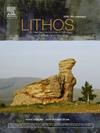加拿大科迪勒拉山系东南部侵入体的年龄和形成深度:对侏罗纪至古新世掘进的影响
IF 2.9
2区 地球科学
Q2 GEOCHEMISTRY & GEOPHYSICS
引用次数: 0
摘要
同步成因的掘起对了解山带的演化非常重要,但由于传统的热时学方法大多对掘起的最后阶段进行测年,因此往往难以辨别。造山过程中喷出的侵入体保留了喷出的时间和深度,因此为阐明这些喷出模式提供了另一种方法。我们将这一概念应用于加拿大科迪勒拉山系南奥明卡带,将43个侵入体中新的和已有的锆石UPb和云母Ar/Ar年龄,以及23个接触金星中新的和已有的喷出深度估算结合起来。文中介绍了 17 项新的锆石 UPb 激光烧蚀电感耦合等离子体质谱分析结果,这些结果跨越了该地区新生代岩浆活动四个阶段的现有年龄范围:中侏罗世(174-154 Ma)、中白垩世(118-95 Ma)、晚白垩世(78-76 Ma)和古新世(66-60 Ma)。与之前认为的白垩纪中期的单一岩浆活动(巴约讷岩浆套)相比,这项新研究发现了白垩纪岩浆活动的两个新的不同时期,分别为 100 ∼ 100 Ma 和 76 Ma。此外,先前被认为是巴约讷岩浆岩组代表的弗莱溪浴成岩、邻近的海岸线岩浆、位于西南 40 公里处的∼60 Ma 纳尔逊岩浆以及 55-62 Ma 瓢虫岩浆岩组构成了该地区新发现的 66-55 Ma 古新世岩浆活动阶段的一部分。然后,将编译的侵入体年龄与根据辉绿岩母岩中发育的接触金星的变质矿物组合确定的置入深度估算值相结合。侏罗纪的侵入体通常具有较高压力的白云石+含安山岩的接触孔(3.3-4.0千巴),深度为12.5-15千米,而白垩纪和古新世的侵入体主要具有较低压力的安山岩+含堇青石的接触孔(2.3-2.9千巴),深度为8.5-11千米。这些数据表明,在科迪勒拉造山运动的中侏罗世(180-160Ma)和中白垩世至古新世(120-60Ma)期间,发生了2-6千米的区域隆升。与此相反,岩浆喷发深度变化了2千米,这表明在中白垩世到古新世之间,加拿大科迪勒拉山系南部发生的掘起活动微乎其微。这种长时间的隆升可能与这一时期压缩变形沿研究区下方的基底解理向东进入前陆有关。本文章由计算机程序翻译,如有差异,请以英文原文为准。
Age and emplacement depth of intrusions in the southeastern Canadian Cordillera: Implications for Jurassic to Paleocene exhumation
Synorogenic exhumation is important for understanding the evolution of mountain belts but is often difficult to discern because traditional thermochronology methods mostly date the final stages of exhumation. Intrusions emplaced during orogenesis provide an alternate method to elucidate these exhumation patterns since they preserve the timing and depth of their emplacement. We apply this concept the southern Omineca belt of the Canadian Cordillera by combining new and existing zircon U![]() Pb and mica Ar/Ar ages from 43 intrusions as well as new and existing estimates of emplacement depth from 23 contact aureoles. Seventeen new zircon U
Pb and mica Ar/Ar ages from 43 intrusions as well as new and existing estimates of emplacement depth from 23 contact aureoles. Seventeen new zircon U![]() Pb laser ablation inductively coupled plasma mass spectrometry results are presented in the paper, spanning the existing range of previous ages for four episodes of Phanerozoic magmatism in this region: Middle Jurassic (174–154 Ma), mid-Cretaceous (118–95 Ma), Late Cretaceous (78–76 Ma), and Paleocene (66–60 Ma). This new work has resolved two new distinct periods of Cretaceous magmatism at ∼100 and ∼ 76 Ma compared to what was previously considered to be a single mid-Cretaceous event (Bayonne magmatic suite). Furthermore, the Fry Creek batholith, previously considered to be emblematic of the Bayonne suite, the adjacent Shoreline stock, the ∼60 Ma Nelson stock located 40 km to the southwest, and the 55–62 Ma Ladybird magmatic suite form part of a newly identified phase of 66–55 Ma Paleocene magmatism in the region. Compiled intrusion ages were then combined with estimates of emplacement depth determined from metamorphic mineral assemblages in contact aureoles developed in pelitic host rocks. Jurassic intrusions typically have higher pressure staurolite + andalusite-bearing contact aureoles (3.3–4.0 kbar) corresponding to depths of 12.5–15 km, whereas Cretaceous and Paleocene intrusions mainly have lower pressure andalusite + cordierite-bearing contact aureoles (2.3–2.9 kbar) corresponding to depths of 8.5–11 km. These data indicate regional exhumation of 2–6 km occurred between the Middle Jurassic (180–160 Ma) and mid-Cretaceous to Paleocene (120–60 Ma) periods of Cordilleran orogenesis. In contrast, pluton emplacement depths changed by <2 km, suggesting minimal exhumation occurred in the southern Canadian Cordillera between the mid-Cretaceous and Paleocene. This extended lull in exhumation may be related to the partitioning of compressional deformation east into the foreland along a basal decollement beneath the study area during this time.
Pb laser ablation inductively coupled plasma mass spectrometry results are presented in the paper, spanning the existing range of previous ages for four episodes of Phanerozoic magmatism in this region: Middle Jurassic (174–154 Ma), mid-Cretaceous (118–95 Ma), Late Cretaceous (78–76 Ma), and Paleocene (66–60 Ma). This new work has resolved two new distinct periods of Cretaceous magmatism at ∼100 and ∼ 76 Ma compared to what was previously considered to be a single mid-Cretaceous event (Bayonne magmatic suite). Furthermore, the Fry Creek batholith, previously considered to be emblematic of the Bayonne suite, the adjacent Shoreline stock, the ∼60 Ma Nelson stock located 40 km to the southwest, and the 55–62 Ma Ladybird magmatic suite form part of a newly identified phase of 66–55 Ma Paleocene magmatism in the region. Compiled intrusion ages were then combined with estimates of emplacement depth determined from metamorphic mineral assemblages in contact aureoles developed in pelitic host rocks. Jurassic intrusions typically have higher pressure staurolite + andalusite-bearing contact aureoles (3.3–4.0 kbar) corresponding to depths of 12.5–15 km, whereas Cretaceous and Paleocene intrusions mainly have lower pressure andalusite + cordierite-bearing contact aureoles (2.3–2.9 kbar) corresponding to depths of 8.5–11 km. These data indicate regional exhumation of 2–6 km occurred between the Middle Jurassic (180–160 Ma) and mid-Cretaceous to Paleocene (120–60 Ma) periods of Cordilleran orogenesis. In contrast, pluton emplacement depths changed by <2 km, suggesting minimal exhumation occurred in the southern Canadian Cordillera between the mid-Cretaceous and Paleocene. This extended lull in exhumation may be related to the partitioning of compressional deformation east into the foreland along a basal decollement beneath the study area during this time.
求助全文
通过发布文献求助,成功后即可免费获取论文全文。
去求助
来源期刊

Lithos
地学-地球化学与地球物理
CiteScore
6.80
自引率
11.40%
发文量
286
审稿时长
3.5 months
期刊介绍:
Lithos publishes original research papers on the petrology, geochemistry and petrogenesis of igneous and metamorphic rocks. Papers on mineralogy/mineral physics related to petrology and petrogenetic problems are also welcomed.
 求助内容:
求助内容: 应助结果提醒方式:
应助结果提醒方式:


